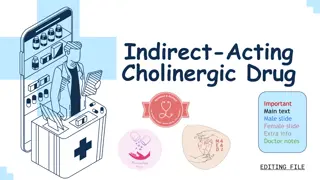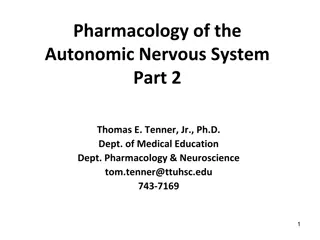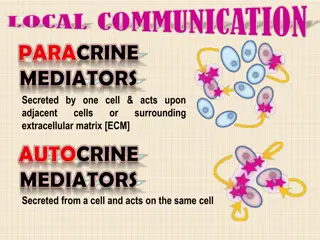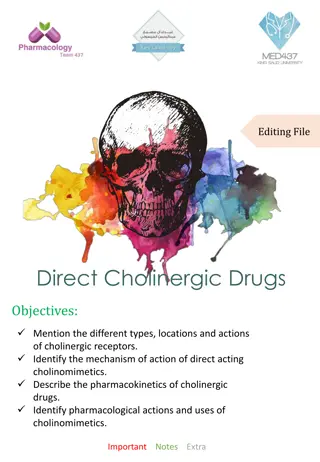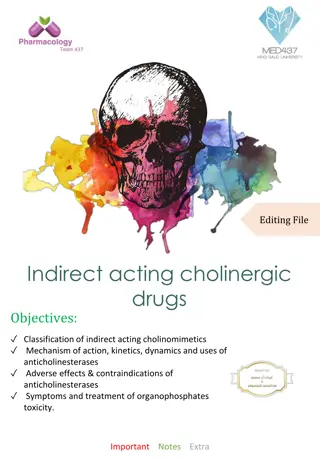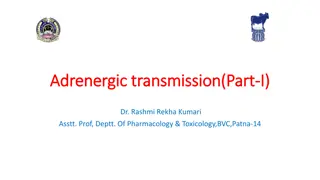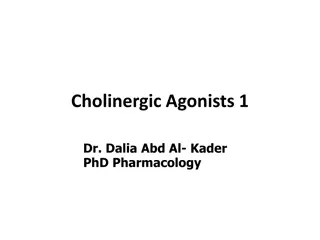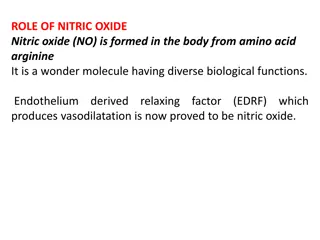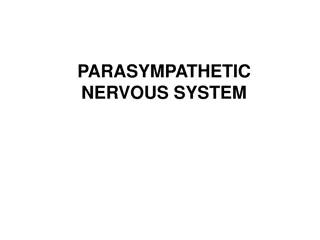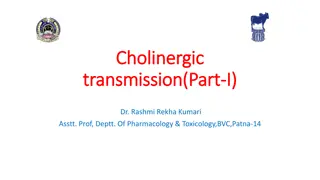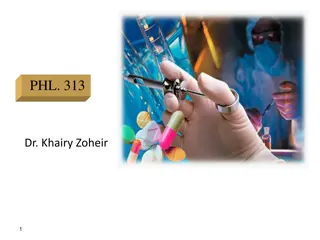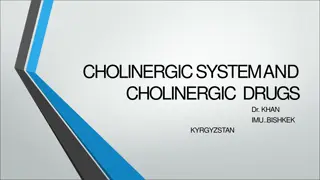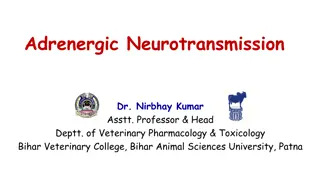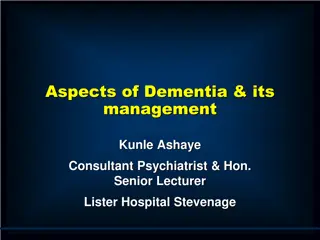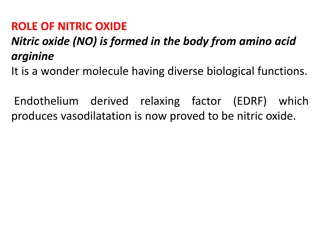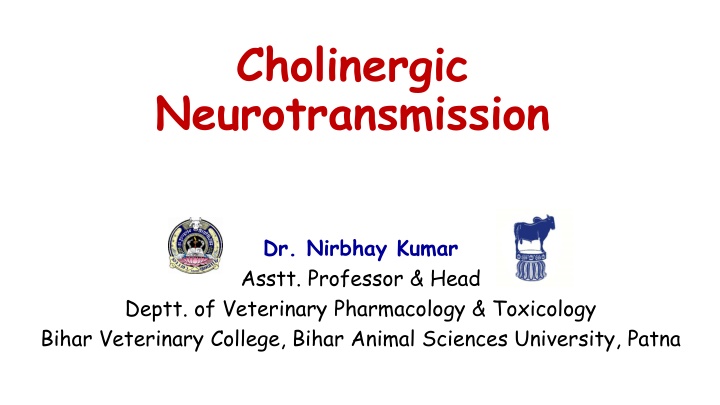
Cholinergic Neurotransmission in Veterinary Pharmacology
Explore the intricate process of cholinergic neurotransmission in veterinary pharmacology, covering synthesis, storage, release, and catabolism of acetylcholine. Discover the key components involved in cholinergic transmission and its impact on various neuroeffector junctions.
Download Presentation

Please find below an Image/Link to download the presentation.
The content on the website is provided AS IS for your information and personal use only. It may not be sold, licensed, or shared on other websites without obtaining consent from the author. If you encounter any issues during the download, it is possible that the publisher has removed the file from their server.
You are allowed to download the files provided on this website for personal or commercial use, subject to the condition that they are used lawfully. All files are the property of their respective owners.
The content on the website is provided AS IS for your information and personal use only. It may not be sold, licensed, or shared on other websites without obtaining consent from the author.
E N D
Presentation Transcript
Cholinergic Neurotransmission Dr. Nirbhay Kumar Asstt. Professor & Head Deptt. of Veterinary Pharmacology & Toxicology Bihar Veterinary College, Bihar Animal Sciences University, Patna
Cholinergic Transmission The impulse transmission on nerve or neuroeffector junction that is mediated by acetylcholine (ACh) is called cholinergic transmission. The different sites of cholinergic transmission are 1. Parasympathetic neuroeffector junctions 2. Autonomic ganglia 3. Adrenal medulla 4. Somatic myoneural junctions 5. Certain regions of CNS.
Synthesis, Storage, Release & Catabolism of Acetylcholine 1. Synthesis: Hemicholinium (a synthesis blocker of ACh) competitively blocks choline uptake in the neurone and thus depletes the ACh stores in the neurone terminals. Uptake of choline is the rate limiting step in the biosynthesis of ACh.
Synthesis, Storage, Release & Catabolism of Acetylcholine continued. 2. Storage: After synthesis in the cytoplasm, ACh is transferred to axonal vesicles in the nerve terminals where it is stored for release whenever necessary. Transport of ACh into synaptic vesicles is blocked by Vesamicol (storage blocker). 3. Release: Two toxins interfere with cholinergic transmission by affecting release 1. Botulinum toxin (release blocker) inhibits release 2.Black widow spider toxin induces massive release and depletion.
Synthesis, Storage, Release & Catabolism of Acetylcholine continued. Figure: A typical cholinergic neuroeffector junction Abbreviations used: ACh : Acetylcholine AChE : ACh esterase CHT : Choline transporter ChAT : Choline acetyl transferase VAChT : Vesicular ACh transporter SNAP : Soluble NSF attachment protein, synaptosome-associated protein
Synthesis, Storage, Release & Catabolism of Acetylcholine continued. 4. Destruction of ACh: After serving the transmitter function, ACh within the junctional space is rapidly inactivated by hydrolysis by a specific enzyme, acetylcholine esterase (AChE). AChE is present in cholinergic nerves, autonomic ganglia and neuromuscular & neuroeffector junctions. A somewhat similar enzyme, butyrylcholinesterase (a pseudocholinesterase) is present in serum and other body tissues. It is primarily synthesized in the liver and its likely vestigial physiological function is the hydrolysis of ingested esters from plant sources.
Differences between two types of cholinesterases Acetylcholinesterase (True Cholinesterase) All cholinergic sites, RBCs, gray matter. Butyrylcholinesterase (Pseudo-cholinesterase) Plasma, liver, white matter (i) Distribution intestine, (ii) Hydrolysis ACh Methacholine Benzoylcholine Butyrylcholine Very fast (in microseconds) Slower than ACh Not hydrolyzed Not hydrolyzed Slow Not hydrolyzed Hydrolyzed Hydrolyzed (iii) Inhibition More sensitive to Physostigmine More sensitive to organophosphates (iv) Function Termination of ACh action Hydrolysis esters. of ingested
Cholinergic Receptors M1 Muscarinic receptors (G-protein coupled receptors) A mushroom plant (Amanita muscaria) alkaloid, muscarine was found to mimic the activity of ACh at the parasympathetic neuroeffector junctions in heart muscle, smooth muscle and secretory glands but not at the previously described nicotinic receptors. So, the type of receptors present at cholinergic neuroeffector junctions in muscle and glands were designated as Muscarinic cholinergic receptors. M2 Muscarinic Receptors M3 M4 Cholinergic Receptors Nicotinic receptors (Ligand gated cation channels) Small doses of nicotine mimicked certain actions of ACh and large doses inhibited the same ACh responses. The nicotinic responsive sites were found to be present in autonomic ganglia, adrenal medullary chromaffin cells and also the neuromuscular junction of somatic nervous system. Accordingly, receptors on these sites were called as Nicotinic cholinergic receptors. M5 N1 (NM) Nicotinic Receptors N2 (NN)
Muscarinic Receptors M1 M2 M3 Location and function subserved Autonomic ganglia: Depolarization Gastric glands: Histamine release and acid secretion CNS: Not precisely known SA node: Hyperpolarization, lowered rate of impulse generation AV node: Lowered velocity of conduction Atrium: Shortening of action potential duration, decreased contractility. Ventricle: Lowered contractility (slight) - due to sparse cholinergic receptors Cholinergic nerve endings: Decreased ACh release Methacholine Methoctramine Visceral smooth muscles: Contraction Exocrine glands: Secretion Vascular endothelium: Release of nitric oxide (NO) vasodilatation Agonist Antagonist Oxotremorine Pirenzepine, Telenzepine Bethanechol Hexahydrosiladifenidol
Nicotinic Receptors NM or N1 NN or N2 Location and function subserved Neuromuscular junction: Depolarization of muscle end plate contraction of skeletal muscle. Autonomic ganglia: Depolarization post-ganglionic impulse. Adrenal medulla: Catecholamine release. CNS: Site specific excitation or inhibition. Agonists Antagonists Tubocurarine, a-Bungarotoxin PTMA, Nicotine DMPP, Nicotine Hexamethonium, Trimethaphan
Actions of Acetylcholine [I]. Muscarinic actions: 1. Heart: SA node : Hyperpolarization, Rate of impulse generation reduced and bradycardia. AV node & His-Purkinje fibres : Conduction slowed. Atria : The force of atrial contraction is markedly reduced. Ventricles : Contractility also reduced but not marked. 2. Blood vessels: Vasodilatation Fall in B.P. Vasodilatation is primarily mediated through EDRF (NO). 3. Smooth muscles: Smooth muscles contracted. Tone and peristalsis in the GI tract is increased and sphincters relax abdominal cramps and evacuation of bowel. Peristalsis in ureter is increased. The detrusor muscle contracts while the bladder trigone and sphincters relax voiding of urine. Bronchial muscles constrict, asthmatics are highly sensitive dyspnoea, precipitation of an attack of bronchial asthma.
Actions of Acetylcholinecontinued.. [I]. Muscarinic actions (continued ): 4. Glands: Secretion from all parasympathetically innervated glands is increased sweating, salivation, lachrimation, tracheobronchial and gastric secretion. The effect on pancreatic and intestinal glands is not marked. Secretion of milk and bile is not affected. 5. Eyes: Contraction of circular muscles of iris miosis. Contraction of ciliary muscles of iris spasm of accommodation, increased outflow facility, reduction in intraocular tension. [II]. Nicotinic actions: 1. Autonomic ganglia: Both sympathetic and parasympathetic ganglia are stimulated. The effect is manifested at higher doses. High dose of ACh given after atropine causes tachycardia and rise in B.P. 2. Skeletal muscles: Contraction of fibre, fasciculations etc.


